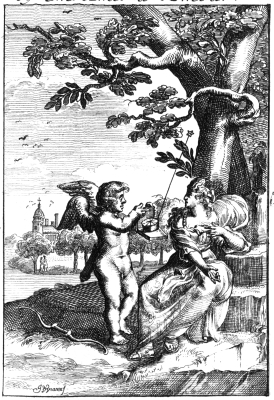Amor mihi Astrum. [39]

Amor mihi Astrum.
Fata regunt homines, blandi junguntur amantes,
Ipso (quis credet) conciliante Deo.
Hic facit ut veluti magnetem Parrhasis ursa,
Ducat amatorem dulcis amica suum.
Ipso (quis credet) conciliante Deo.
Hic facit ut veluti magnetem Parrhasis ursa,
Ducat amatorem dulcis amica suum.
L'Occhio amato è la mia stella.
Il supremo motor quasi preseriue
A tutti un mezzo che l'Amante inuita,
Come il settentrion la calamita;
Non può fuggir alcun quelche'l ciel seriue.
A tutti un mezzo che l'Amante inuita,
Come il settentrion la calamita;
Non può fuggir alcun quelche'l ciel seriue.
Son oeil est mon Nord.
De mesme que l'aimant Suit le Nord qui l'attire,
Ainsi lorsque deux coeurs par unarrêt du Sort.
Lun pour l'autre formez se content leur martire,
Chacun deux a linstant se porte uers son Nord.
Ainsi lorsque deux coeurs par unarrêt du Sort.
Lun pour l'autre formez se content leur martire,
Chacun deux a linstant se porte uers son Nord.
Haar Oog is mijn Noord ster.
Gelyk de Zeilsteen Volgd het Noorden waar het is,
Zo Volgd een Minnaar Steets na zyn Bemindens Oogen.
Als hy 't Gezicht van haar moet derven, 't is gewis,
dat, Schoon 't Onmooglyk is, hy Steets na haar Zal Pogen.
Zo Volgd een Minnaar Steets na zyn Bemindens Oogen.
Als hy 't Gezicht van haar moet derven, 't is gewis,
dat, Schoon 't Onmooglyk is, hy Steets na haar Zal Pogen.
Translations
Literature
Sources and parallels
-
Same pictura, slightly altered, different motto, same Latin subscriptio: Ero navis amoris, habens te astrum lucidum [20] (in: Otto Vaenius, Amorum emblemata (1608))
[Compare
![Compare [compare]](/static/images/compare2.gif) ]
]
-
The power of love compared with the power of magnetism also in:Animos nil dirimit. [49] (in: Jacob Cats, Sinne- en minnebeelden (1627))
[Compare
![Compare [compare]](/static/images/compare2.gif) ]
]
-
The power of love compared with the power of magnetism also in:Animos nil dirimit. [48] (in: Jacob Cats, Proteus (1618))
[Compare
![Compare [compare]](/static/images/compare2.gif) ]
]
References, across this site, to this page:
- Animos nil dirimit. [48] (in: Jacob Cats, Proteus (1618))
- Animos nil dirimit. [49] (in: Jacob Cats, Sinne- en minnebeelden (1627))
- Ero navis amoris, habens te astrum lucidum [20] (in: Otto Vaenius, Amorum emblemata (1608))
Iconclass
A cupid points at a compass, while facing a lady; the Pole star is linked to the compass lovers in the background- stars
[24D]

- groups of trees
[25G11]

- landscape with tower or castle
[25I5]

- sitting on an elevation - AA - female human figure
[31AA2352]

- lover (woman) alone (e.g. longing for the beloved)
[33C2162]

- lovers' meeting
[33C22]

- couple of lovers
[33C23]

- archer's weapons: bow
[45C15(BOW)]

- quiver
[45C23]

- quadrant, sextant, octant (nautical instruments)
[46C2822]

- letter, envelope
[46E221]

- Strength, Power; 'Fortezza', 'Fortezza d'Animo e di corpo', 'Fortezza del corpo congiunta con la generosité dell'animo', 'Fortezza
& valore del corpo congiunto con la prudenza & virtù del animo', 'Forza' (Ripa) (+ emblematical representation of concept)
[54A7(+4)]

- (personifications and symbolic representations of) Love; 'Amore (secondo Seneca)' (Ripa) (+ emblematical representation of
concept)
[56F2(+4)]

- proverbs, sayings, etc. (with TEXT)
[86(AMOR MIHI ASTRUM)]

- other non-aggressive activities of Cupid
[92D156]

- attributes of Cupid (with NAME)
[92D18(BOW)]

- attributes of Cupid (with NAME)
[92D18(QUIVER)]

![[H O M E : Emblem Project Utrecht]](/static/images/rd-small.gif)
















































